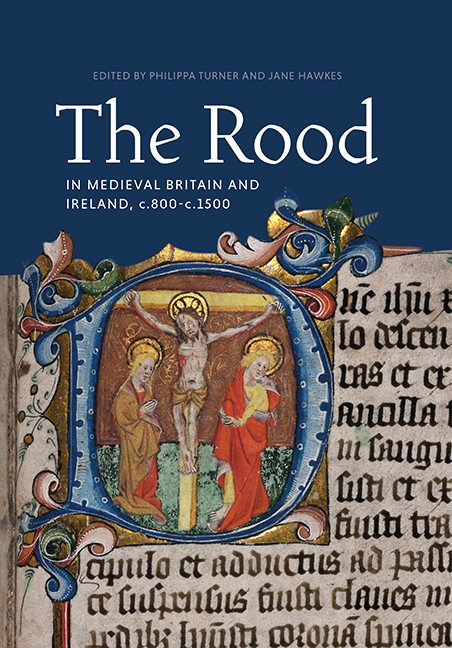Book contents
- Frontmatter
- Contents
- List of Illustrations
- List of Contributors
- Acknowledgements
- List of Abbreviations
- 1 Introduction: Rethinking the Rood
- 2 Approaching the Cross: The Sculpted High Crosses of Anglo-Saxon England
- 3 The Mark of Christ in Wood, Grass and Field: Open-Air Roods in Old English Medical Remedies
- 4 Twelfth-Century English Rood Visions: Some Iconographic Notes
- 5 Crosses, Croziers and the Crucifixion: Twelfth-Century Crosses in Ireland
- 6 From Religious Artefacts to Symbols of Identity: The Role of Stone Crosses in Galician National Discourse
- 7 The Rood in the Late Medieval English Cathedral: The Black Rood of Scotland Reassessed
- 8 The Cross of Death and the Tree of Life: Franciscan Ideologies in Late Medieval Ireland
- 9 Heralding the Rood: Colour Convention and Material Hierarchies on Late Medieval English Rood Screens
- 10 Reframing the Rood: Fifteenth-Century Angel Roofs and the Rood in East Anglia
- Bibliography
- Index
- Already Published
- Plate Section
3 - The Mark of Christ in Wood, Grass and Field: Open-Air Roods in Old English Medical Remedies
Published online by Cambridge University Press: 07 November 2020
- Frontmatter
- Contents
- List of Illustrations
- List of Contributors
- Acknowledgements
- List of Abbreviations
- 1 Introduction: Rethinking the Rood
- 2 Approaching the Cross: The Sculpted High Crosses of Anglo-Saxon England
- 3 The Mark of Christ in Wood, Grass and Field: Open-Air Roods in Old English Medical Remedies
- 4 Twelfth-Century English Rood Visions: Some Iconographic Notes
- 5 Crosses, Croziers and the Crucifixion: Twelfth-Century Crosses in Ireland
- 6 From Religious Artefacts to Symbols of Identity: The Role of Stone Crosses in Galician National Discourse
- 7 The Rood in the Late Medieval English Cathedral: The Black Rood of Scotland Reassessed
- 8 The Cross of Death and the Tree of Life: Franciscan Ideologies in Late Medieval Ireland
- 9 Heralding the Rood: Colour Convention and Material Hierarchies on Late Medieval English Rood Screens
- 10 Reframing the Rood: Fifteenth-Century Angel Roofs and the Rood in East Anglia
- Bibliography
- Index
- Already Published
- Plate Section
Summary
The importance of the sign and image of the Christian cross in medieval England cannot be underestimated. From the carpet pages of high-status manuscripts such as the Lindisfarne Gospels, into which the image of the cross is constantly woven, to the simple and ephemeral sign of the cross made upon the body in prayer, there seems to have been no part of Christian spirituality during this era of which it was not an integral part.
The study of liturgy and religious practice in the early Middle Ages has received a great deal of attention in recent years, including devotion to the Holy Cross, which has been analysed from a variety of disciplinary perspectives in the three volumes of the Sancta Crux/Halig Rod project edited by Karen Jolly, Catherine Karkov and Sarah Larratt Keefer. This series investigates subjects such as the blessings of crosses in English pontificals; Karen Jolly has also looked specifically at the use of the cross in healing and protection, noting how frequently its image is used in different kinds of ritual performance, for spiritual defence and healing rites, identifying folk medicine as being deeply indebted to Christian liturgy and devotion, both public and private. Of particular relevance to this chapter, the different terms used for the cross are studied by Ursula Lenker, who explores the three ways of making the gesture of the sign of the cross, and examines in detail the specific meanings of the terms rodetac(e)n, cristes mæl and cruc. This chapter will specifically focus on cristes mæl (Christ's mark) in the sense of a physical cross which can be touched and used, and in particular on five medical remedies in Old English medical collections. Of these, three do not specify from which materials the cristes mæl would have been made, but as they involve removing lichen from the cross, it is implied that they are permanent features of the landscape; all three of these remedies are for mental or spiritual afflictions. They will be compared with similar references to cristes mælu in charters, penitentials, and Bede's Historia ecclesiastica gentis Anglorum, in which the cross is used as a marker of land, a place of prayer, and a site of healing. The remaining two remedies are not for human illnesses, but for problems affecting food sources: lung disease in cattle and infertility in fields.
- Type
- Chapter
- Information
- The Rood in Medieval Britain and Ireland, c.800-c.1500 , pp. 31 - 44Publisher: Boydell & BrewerPrint publication year: 2020



